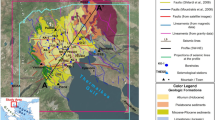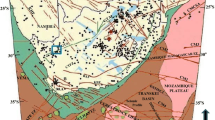Abstract
2-D shallow velocity structure is derived by travel-time inversion of the first arrival seismic refraction and wide-angle reflection data along the E–W trending Narayanpur–Nandurbar and N–S Kothar–Sakri profiles, located in the Narmada–Tapti region of the Deccan syneclise. Deccan volcanic (Trap) rocks are exposed along the two profiles. Inversion of seismic data reveals two layered velocity structures above the basement along the two profiles. The first layer with a P-wave velocity of 5.15–5.25 km s−1 and thickness varying from 0.7–1.5 km represents the Deccan Trap formation along the Narayanpur–Nandurbar profile. The Trap layer velocity ranges from 4.5 to 5.20 km s−1 and the thickness varies from 0.95 to 1.5 km along the Kothar–Sakri profile. The second layer represents the low velocity Mesozoic sediments with a P-wave velocity of 3.5 km s−1 and thickness ranging from about 0.70 to 1.6 km and 0.55 to 1.1 km along the E–W and N–S profiles, respectively. Presence of a low-velocity zone (LVZ) below the volcanic rocks in the study area is inferred from the travel-time ‘skip’ and amplitude decay of the first arrival refraction data together with the prominent wide-angle reflection phase immediately after the first arrivals from the Deccan Trap formation. The basement with a P-wave velocity of 5.8–6.05 km s−1 lies at a depth ranging from 1.5 to 2.45 km along the profiles. The velocity models of the profiles are similar to each other at the intersection point. The results indicate the existence of a Mesozoic basin in the Narmada–Tapti region of the Deccan syneclise.












Similar content being viewed by others
References
Cerveny, V., Molotkov, I.A., and Psencik, I, Ray Method in Seismology, (University of Karlova, Prague 1977).
Dixit, M.M., Satyavani, N., Sarkar, D., Khare, P., and Reddy, P.R. (2000), Velocity inversion in the Lodhika well area, Saurashtra peninsula, western India, First Break 18, 499–504.
Greenhalgh, S.A. (1977), Comments on ‘The hidden layer problem in seismic refraction work’, Geophys. Prospect. 25, 179–181.
Jarchow, C.M., Catchings, R.D., and Lutter, W.J. (1994), Large explosive source, wide-recording aperture, seismic profiling on the Columbia Plateau, Washington, Geophysics 59, 259–271.
Kaila, K.L. (1988), Mapping the thickness of Deccan Trap flows in India from DSS studies and inferences about a hidden Mesozoic Basin in the Narmada-Tapti Region, Geol. Soc. of Ind., 91–116.
Kaila, K.L., Krishna, V.G., and Mall, D.M. (1981), Crustal structure along Mehmadabad-Billimora profile in the Cambay basin, India, from Deep Seismic Soundings, Tectonophysics 76, 99–130.
Kalachand Sain, Zelt Colin, A., and Reddy, P.R. (2002), Imaging of subvolcanic Mesozoics in the Saurashtra peninsula of India using travel-time inversion of wide-angle seismic data, Geophys. J. Int. 150, 820–826.
Lutter, W.J., Catchings, R.D., and Jarchow, C.M. (1994), An image of the Columbia Plateau from inversion of high-resolution seismic data, Geophysics 59, 1278–1289.
Mahadevan, T.M. (1994), Deep continental structure of India: A review. Mem. Geol. Soc. India 28, 239–301.
NGRI Technical Report. (1998), Integrated geophysical studies for hydrocarbon exploration, Saurashtra, India, NGRI Technical Report No. NGRI-1998-Exp-239.
NGRI Technical Report. (2000), Integrated geophysical studies for hydrocarbon exploration, Kutch, India, NGRI Technical Report No. NGRI-2000-Exp-296.
NGRI Technical Report. (2004), Integrated geophysical studies for hydrocarbon exploration, Deccan Syneclise, India, NGRI Technical Report No. NGRI-2003-Exp-404.
O’ Leary, D.M., Ellis, R.M., Stephenson, R.A., Lane, L.S., and Zelt, C.A. (1995), Crustal structure of the northern Yukon and Mackenzie delta, north-western Canada, J. Geophys. 100, 9905–9920.
Prasad, B.N., Khan, S., and Giridhar Lal, (1994), Hydrocarbon prospects of Kutch Basin onland, India, J. Assoc. Expl. Geophys. 15(4), 161–169.
Pujol, J., Fuller, B.N., and Smithson, S.B. (1989), Interpretation of a vertical seismic profile conducted in the Columbia Plateau basalts, Geophysics 54, 1258–1266.
Sain, K., Bruguier, N., Murty, A.S.N., and Reddy, P.R. (2000), Shallow velocity structure along the Hirapur-Mandla profile in central India, using travel-time inversion of wide-angle seismic data and its tectonic implications, Geophys. J. Int. 142, 505–515.
Sain, K. and Kaila, K.L. (1996), Interpretation of first arrival travel-times in seismic refraction work, Pure Appl. Geophys. 147, 181–194.
Singh, D., Alat, C.A., Singh, R.N., and Gupta, V.P. (1997), Soure rock characteristics and hydrocarbon generating potential of Mesozoic sediments in Lodhika Area, Saurashtra Basin, Gujarat, India. Proc. Second Int. Pet. Conference and Exbn. Petrotech-97, New Delhi, India, pp. 205–220.
Sridhar, A.R. and Tewari, H.C. (2001), Existence of a sedimentary graben in the western part of Narmada zone: Seismic evidence, J. Geodyn. 31, 19–31.
Sreenivasan, R., Jafri, S.H., Rao, G.V., and Reddy, G.K. (1998), Phreatomagmatic eruptive centre from the Deccan Trap Province, Jabalpur, central India, Current Science 74, 9, 787–790.
Tewari, H.C., Dixit, M.M., and Murty, P.R.K. (1995), Use of travel-time skips in refraction analysis to delineate velocity inversion, Geophys. Prospect. 43, 793–804.
Whiteley, R.J. and Greenhalgh, S.A. (1979), Velocity inversion and the shallow seismic refraction method, Geoexploration 17, 125–141.
White, R. and McKenzie, D. (1989), Magmatism at rift zones: The generation of volcanic continental margins and flood basalts, J. Geophys. Res. 94, 7685–7729.
Zelt, C.A. and Smith, R.B. (1992), Seismic travel-time inversion for 2-D crustal velocity structure, Geophys. J. Int. 108, 16–34.
Zelt, C.A. (1999), Modeling strategies and model assessment for wide-angle seismic travel-time data, Geophys. J. Int. 139, 183–204.
Zelt, C.A. and Ellis, M. (1988), Practical and efficient ray tracing in two-dimensional media for rapid travel-time and amplitude forward modeling, Can. J. Expl. Geophys. 24, 16–31.
Acknowledgements
We are thankful to the Director, National Geophysical Research Institute (NGRI) Hyderabad, Dr. V.P. Dimri, for his constant encouragement and kind permission to publish this paper. We also thank the Oil Industry Development Board (OIDB), Govt. of India for supporting the project in the Deccan syneclise. We great fully acknowledge and thank the CSS crew of NGRI for successfully completing the fieldwork along the profiles in the Deccan syneclise. We sincerely thank Dr. Ivan Psencik and the two anonymous reviewers for their valuable suggestions to improve the quality of the figures and manuscript. We thank S/Shri. V. Rajasekhar, M.Sankaraiah, B.P.S. Rana for preparing the figures.
Author information
Authors and Affiliations
Corresponding author
Rights and permissions
About this article
Cite this article
Murty, A.S.N., Rajendra Prasad, B., Koteswara Rao, P. et al. Delineation of Subtrappean Mesozoic Sediments in Deccan Syneclise, India, Using Travel-Time Inversion of Seismic Refraction and Wide-Angle Reflection Data. Pure Appl. Geophys. 167, 233–251 (2010). https://doi.org/10.1007/s00024-010-0050-z
Received:
Revised:
Accepted:
Published:
Issue Date:
DOI: https://doi.org/10.1007/s00024-010-0050-z




